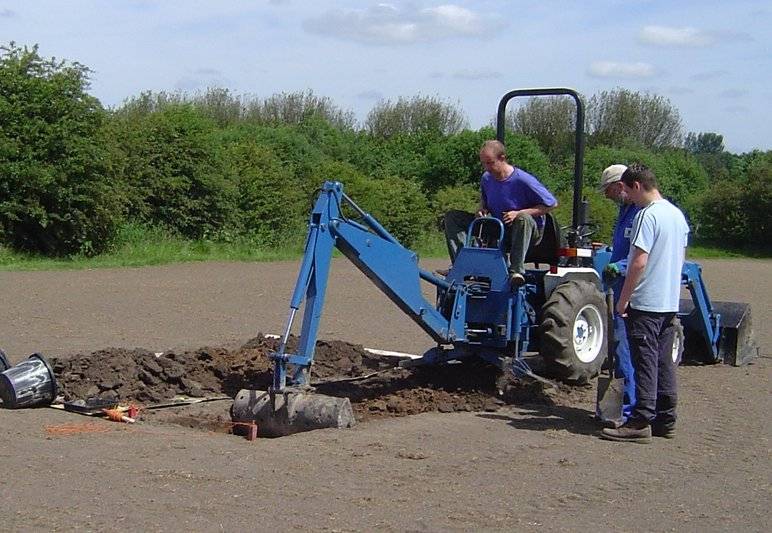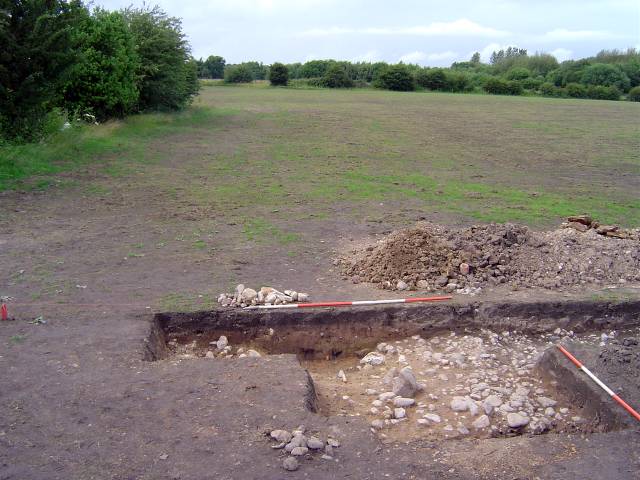 At long last the south
field at Brimelow Farm has become available for excavation. This is the field where, in
the summer of 2002, we conducted a resistivity survey in search of the Roman Road from
Wigan to Walton-le-Dale (see Newsletters 54 and 55). Last year the farmer, Roy Brandon, grew
turf here, but now having cleared it, has allowed us access for some limited
investigations. Our 2002 survey did not give particularly good results but there were some
indications for us to follow. The farmer, having already re-seeded, was keen to proceed
quickly and even helped us with the loan of his small mechanical excavator. The first
trench was put in near our previous excavations in 1989 where possible features had been
recorded. The result, however, was disappointing with only a small scattering of small
stone cobbling. The depth of sub-soil here is quite thin and we suspect constant ploughing
over the years may have destroyed anything in this area. We decided to move our
investigations to a strong anomaly in the northwest corner of our surveyed area. This area
also coincides with the point where the Standish Wigan boundary changes direction as it
crosses the field a few metres in from the hedgerow (could this be the remains of a marker
such as a stone cross?). Once again the result was disappointing - there was nothing in
the trench, not even the usual smattering of stones. The sub-soil, which is a hard clay,
lies on top of the natural softer sandy clay. At this point the sub-soil was certainly
thicker and this may be the explanation for the survey anomaly. At long last the south
field at Brimelow Farm has become available for excavation. This is the field where, in
the summer of 2002, we conducted a resistivity survey in search of the Roman Road from
Wigan to Walton-le-Dale (see Newsletters 54 and 55). Last year the farmer, Roy Brandon, grew
turf here, but now having cleared it, has allowed us access for some limited
investigations. Our 2002 survey did not give particularly good results but there were some
indications for us to follow. The farmer, having already re-seeded, was keen to proceed
quickly and even helped us with the loan of his small mechanical excavator. The first
trench was put in near our previous excavations in 1989 where possible features had been
recorded. The result, however, was disappointing with only a small scattering of small
stone cobbling. The depth of sub-soil here is quite thin and we suspect constant ploughing
over the years may have destroyed anything in this area. We decided to move our
investigations to a strong anomaly in the northwest corner of our surveyed area. This area
also coincides with the point where the Standish Wigan boundary changes direction as it
crosses the field a few metres in from the hedgerow (could this be the remains of a marker
such as a stone cross?). Once again the result was disappointing - there was nothing in
the trench, not even the usual smattering of stones. The sub-soil, which is a hard clay,
lies on top of the natural softer sandy clay. At this point the sub-soil was certainly
thicker and this may be the explanation for the survey anomaly.
The farmer then spoke of all the stone cobbles constantly coming out of this field (he
even has a special machine for removing them). However at the other end of the field there
are less stones and he suggested that, if the Road is there, it might be buried at a lower
depth and therefore suffered less damage. We decided to switch our search to this area.
Firstly, we carried out another resistivity survey and once again results were not
convincing, but at least gave us encouraging signs where to start. Our first cut again
produced nothing. However, as we extended westward, to our relief the cobbles started to
appear. We continued with this trench on the following day and, by the time we had reached
the other side of the surveyed area, we had uncovered a 9 metre wide strip of cobbling.
Its appearance is similar to the section uncovered in the north field in our excavations
in 1988 and, having checked the alignment with this section and field boundaries appearing
on the 1849 6” OS map, the alignment appears quite striking. I am therefore convinced
we have uncovered the remains of the Roman Road. There are some indications of a shallow
ditch on the west side and work is continuing to see if we can detect a similar one on the
east side. The farmer has very kindly given us a little longer to record our findings and
at our next meeting we will be able arrange further site visits.
National Archaeology Days
17th July – Oxford Archaeology North who are based in Lancaster will be opening
their doors for everybody to see the work they are doing in the North West. There will be
something for all the family including displays, artefact handling, quizzes, practical
sessions and talks. The venue is the Storey Institute in Lancaster with its entrance
opposite the Castle and will run from 10.30 am to 4.00 pm.
17th July – Dr David Hunt from the South Ribble Museum will me giving a lecture
entitled “Still Digging: An introduction to Archaeology”. The venue is the
museum at The Old Grammar School, Church Road, Leyland starting at 11.00 am. The contact
No. is 01772 422041.
18th July – Dr David Hunt will also be giving a 4 mile guided walk entitled
‘England’s greatest treasure - the Cuerdale Hoard’. His walk will start at
2.00pm from the Health Centre, Victoria Road, Walton-le-Dale.
Next Meeting
Wednesday 7th July at the BP Centre (Scout HQ) in Greenough Street, starting at 7.30 pm
as usual. This month’s speaker is Tony Burnett who was to have given his talk last
month. Tony gave us a fascinating guided tour of the Lune Valley in 2002 (see Newsletter
No.56) tracing the Roman Roads in that area. His talk is a follow up to this and I am sure
it will be as fascinating as the tour itself.
Hope to see you there. B.A.
|



